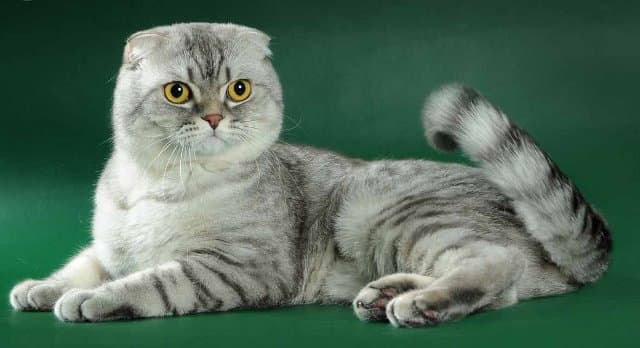Whoever has a cat can not be afraid of loneliness.
Daniel Defoe
The breed of Scottish Fold cats (Scottish Fold) is relatively young: it appeared in 1961 in Scotland, from where it got its name. For the first time the lop-eared cat was born accidentally, but then the breeders decided to fix the corresponding gene, tk. they really liked him. Since then, the breed has undergone many modifications, as a result of which those sick kittens were born, then the desired spout did not turn out, then the ears were lying wrong, but today the Scottish Folded Shorthair cat differs in baby face and the ears pressed to the head, which does not repeat more than one breed of the world. This pet always looks childish, which is complemented by plush hair, like a small bear, and a good character. It is thanks to such advantages that Scottish fold has become extremely popular all over the world.
What does a Scottish Fold cat look like?
The photo below shows the Scottish Fold cats and cats, which are good representatives of the breed with pronounced its signs.
When choosing a kitten, it is worth considering that not all Scots are of equal quality. It's one thing when you buy an animal in a breed-class cattery, quite another - on the bird market or on an announcement from an unverified breeder. But in fact, as a child, a cat has either strong breeds recognized, or not. And a substandard kitten bought from someone who is not clear will grow into a simple mug if you do not check the presence of strong breed qualities yourself to make it difficult for the average person to do.
You can look at the photo below a few photos from the ads, which say that they are selling thoroughbred Scottish seals. How do you like them?

Now let's see what a really good Scottish kitten should look like.

Well, so that in principle you could imagine a standard of the breed, we present you cats-champions who received titles at various exhibitions.
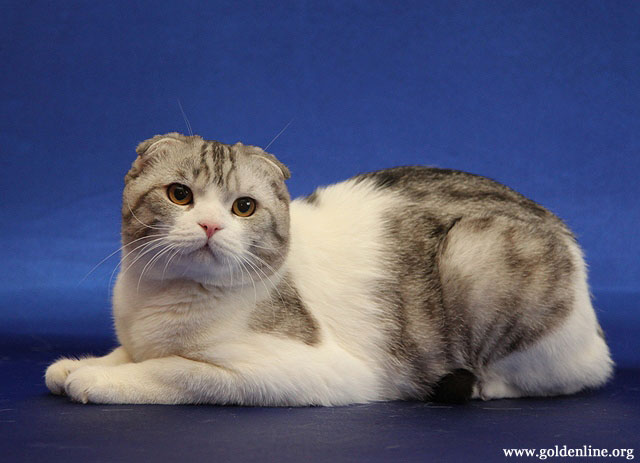 And a great international champion WCF
And a great international champion WCF
Scottish Fold: breed description and standards
Weight and size
The weight and size of Scottish folds is considered average: females weigh approximately 3.5-4 kg, males - 5 kg. But how much the Scottish Fold cat weighs, also depends on its diet and lifestyle. Scots are not inclined to fullness as much as, for example, the British, but busting from them still happens, especially if the individual is sterilized. For such pets it is necessary to choose a special food and invent physical exercises.
The size of the Scottish Fold cat - about a meter with elongated limbs, without a tail.
Tail
The tail at normal length reaches the blades if it is folded along the body. The tail of a Scottish cat should be mobile and long enough. If this is not the case, we are dealing with a problem where the gene of the lop-eared significantly affected the health of the musculoskeletal system.
Feet and spine
The feet with the spine, looseness and ease of movement are also checked. This is very important for Scottish folds. Because of the gene of the lop-eared they are at risk for joint diseases.
In general, the healthy Scots body is muscular and strong, and the hind legs are joggling.
Wool
The coat of Scottish Fold cats is dense, fairly short, thick, with a good undercoat that does not allow it to lie down. All this creates a feeling of plush. Read also more about scottish cat colors .
Ears
But the main features of Scottish Fold cats - this is, first of all, ears. It is in them is the difference between Scottish folds and Scottish Straights (Scottish pryamouhih cats). The ears of Scottish Fold cats should have folds, aerobatics - when their 3. Right ears drop a little forward and down, making the head spherical.
All Scottish seals are born with standing ears, but on the 21st day they begin to fall in the folds. Nevertheless, how tightly the ears will fit to the head, or even a little stand up and turn into so-called helicopters, which is a marriage, it is difficult even to say to a professional breeder. But there is a rule: ears with one fold are almost always raised afterwards, ears with two folds slightly rise, but ears with three folds (the bottom fold is located 3-5 mm from the tip of the ear) are rare, but they make the ears champion, and the head perfectly round. Compare three photos: on the first - ideal ears, on the second - hardly raised, on the third - helicopters. There is a difference?
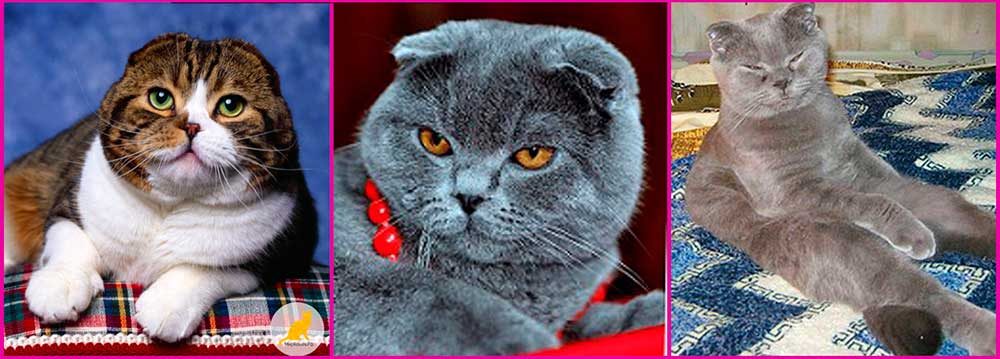
It often happens that when the ears in the fold completely rise, the breeder rewrites the family tree, calling the cat a straight. But this is actually fold, that is, the carrier of the lop-eared gene, only with raised ears. As a result, such cats are knit with other folds, which is forbidden by the rules of breeding, and from these unions defective kittens are born.
In order not to confuse the "risen" fold with the straight, you need to look at the size of the ears: they have very very small folds, even if they stand. Strikes also have full-fledged large cat's locators, but, of course, they are not too big, otherwise this is also a drawback.
Nevertheless, no honest breeder will not give any guarantees when selling a kitten that the ears will not rise afterwards. After all, it depends on the health of the pet, on its hormonal background, on nutrition, on the presence of stress and on many other factors.
Muzzle
Like Scotty Straight, Scottish folds have a round face due to dense cheeks and pronounced cheekbones, a strong jaw, and a round shape of the skull. This is another reason why the same cherished baby face appears. But she is not the last.
Eyes
Even for this effect, the Scottish cat needed more round eyes, which sometimes resemble the surprised eyes of an owl. Color - from blue to amber, depending on the color of the coat. And it can be either monophonic, or with a pattern or with different colors of the base and the tip of the hairs.
Nose
Pay attention to the nose of the cat. It should not have humpbacks or deflections and should be short enough. It is the short nose that ends the portrait called baby face. But it is not all Scots. Some, the so-called old-type Scottish cats, have an elongated nose shape. However, now competent breeders are working to ensure that the spouts of Scottish folds are more and more accurate.
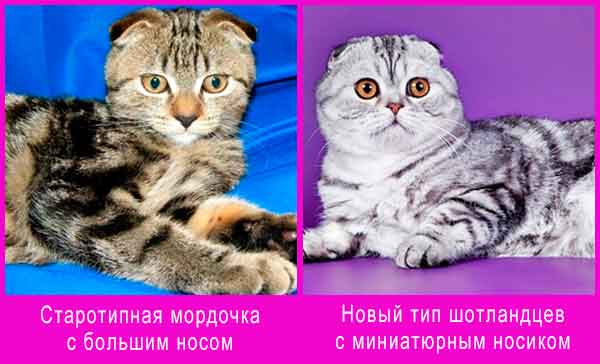
LIMITATIONS
Disadvantages of appearance in Scottish folds are too large or upturned ears, heavy skeleton, like a British, flat forehead, bent back, curved hind legs, any other abnormalities of the skeleton structure, rigid or fixed tail, too short tail, creaking and clicking intervertebral joints, a hook on the tail, an incorrect number of fingers or fused fingers, wide ears, cryptorchidism (a phenomenon when the testes have cages inside).
Disqualification for a cat is announced for ears-helicopters, a hook on the tail, too short a tail, a rigid and immobile tail with thick vertebrae, wrong number of fingers, soreness and stiffness of movements, poor health in general.
EVALUATIONS AT EXHIBITIONS
At exhibitions, Scottish cats are rated on a 100-point scale. Points are distributed as follows. Head: muzzle, head shape, neck, chin - maximum score 15 points, eyes - 15 points, ears - 25 points. Body: paws, body - 10 points, wool - 10 points, tail - 20 points. Color: wool and eyes - 5 points.
The breed is short-haired, the Scottish Fold has an international SFS code.
Scottish Fold: character
The character of the Scottish Fold cat is praised by breeders and scolded by many owners. The first say that these are plush creatures both outside and inside, that they are complaisant, kind, absolutely not aggressive, and the like. The latter sometimes encounter the completely opposite picture. Why is this happening?
In advertising brochures, they always present the product better than it actually is. So it turns out here. Quite plush character in the Scots, in fact, no. They are rather capricious cats, sometimes capricious, not always obedient, and defending themselves, for example, from some unpleasant procedure, they can cause serious injuries and look completely unflattering. There are also bandits who constantly hunt the feet of the hosts, attack, etc. But this is a deviation.
To foresee what will be your cat, it's difficult. After all, each has its own individual set of genes. Look at how the kitten behaves in the breeder's house, look at his mother. Try to find out if someone is offending him. Because of the original conditions of detention, too much depends.
And further the personality of the seal is very strongly formed under the influence of his mother. If the cat is separated from her too soon, up to 2 months, he will not be a fully-formed person and not sufficiently educated - he will release claws during the game, he will not know the tray and the scratching pad. And in general, taking a pet from his mother too early, you provoke the development of his psychological problems in the future and in fact deprive him of his childhood.
Also much will depend on education in a new family. You can not let the cat do anything, allow you to scratch, walk past the tray. It will have to methodically accustom to the rules of behavior among people.
But suppose you took the kitten from the mother after 2 months, the breeder had chocolate conditions, you bring him up more or less correctly and he did not get the aggressive genes unusual for the Scots. What, then, is the average Scottish cat with an average character? He will be kind and cheerful. As a child, he can be hyperactive, although he can be calm. He will have a simple enough character, unlike, for example, from severe Norwegian, Angora or Siamese cats. Simple in terms of nezlamamyatnosti, without deliberate shoes and revenge. In this regard, Scottish cats - plush, it's true.
As for the negative aspects, it is, first of all, a dislike for sitting on your hands and excessive squeezing. Well, in general, manipulate yourself and abuse your position of the owner of the Scottish kitty will not allow.
The key to understanding the nature of a Scottish cat lies in your respect for her. If you respect her personal space, do not miss out on your hands, do not torment yourself with active caresses, do not make too noisy games, you will get a great friend who in some ways will even resemble a dog - Scottish seals are very attached to their masters.
There are many different breeds of cats in the world. They are bald and fluffy, with a curly and even fur, with and without tails. Among all this diversity, one of the most popular and adored seals are Scottish folds.
These animals have incredible charm, thanks to their miniature pressed ears. This main characteristic of the breed makes the heads of cats more round, giving the muzzle and large, slightly protruding eyes a touching charm, no matter how many pets there are, until old age.
Origin of the breed
The initial information about cats with drooping ears goes back to the literature of the East of the 19th century. But such animals were not interested in cat lovers in China, so they did not become popular there.
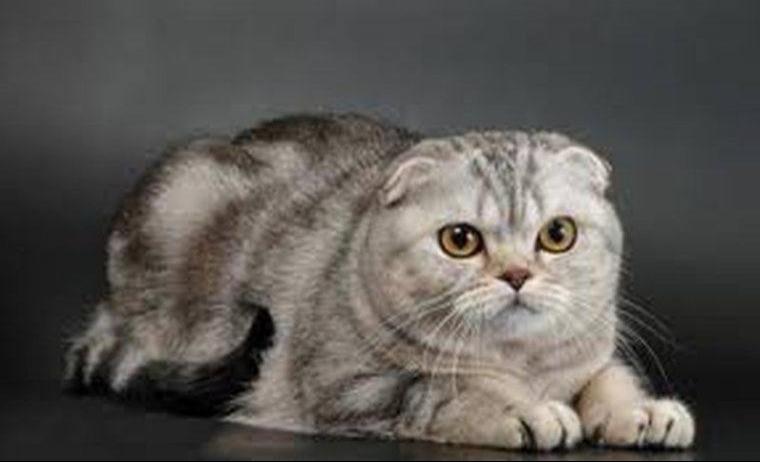
But such animals in 1961 became famous in Scotland. This they owe to William Ross. He found a bright female, whom Suzie called. The case was on farmland near the town of Kupar Angus in the district of Teisand. Unusual exterior, bent envelope and flattened ears, such cats are required to inherit this ear strain.
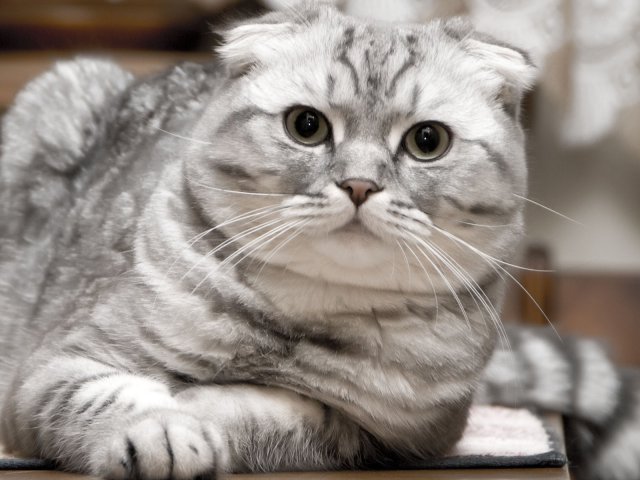
Scottish folds were created as a breed with the help of closely related Britons and American women with short wool. Some kittens were obtained with drooping ears, while others were pryamuhimi.
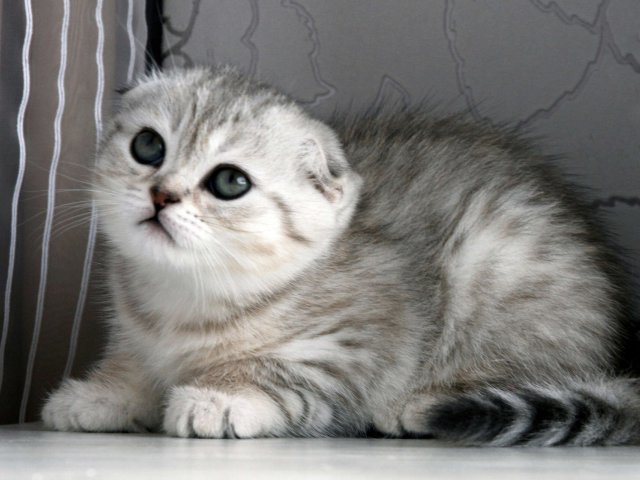
After a couple of generations of Suzy's cubs, Ross's spouses tried to introduce the newly minted breed to formal registration.
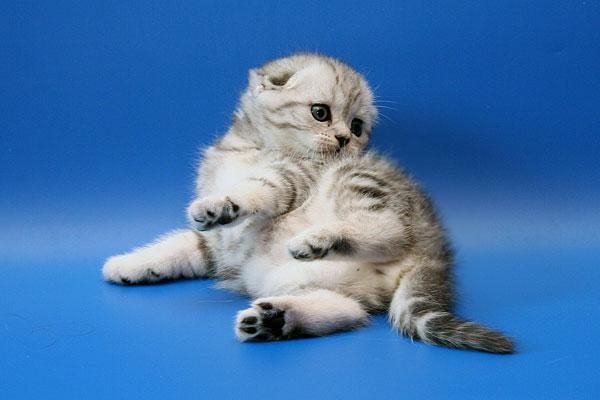
But not every world organization of felinologists accepted with delight the phenomenon of the Scottish Fold. For example, the British world association FIFE and to this day does not consider Scottish folds a breed because of genetically mutated auricles (you can see it here).
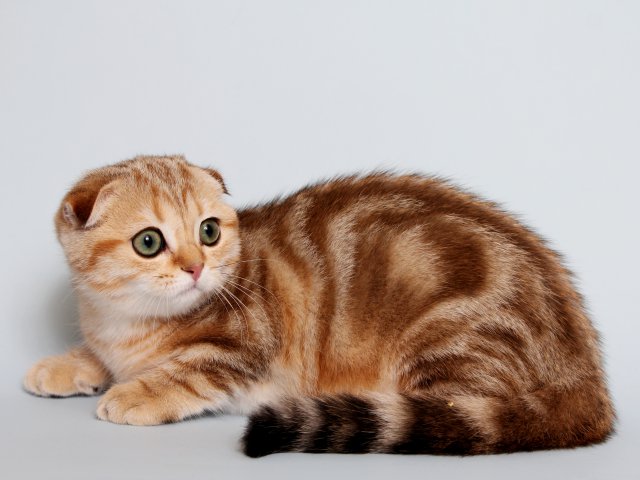
Another organization in England first took the breed, but later began to reject individuals with pressed ears, considering the main characteristic deviation and prohibiting the selection of these cats.
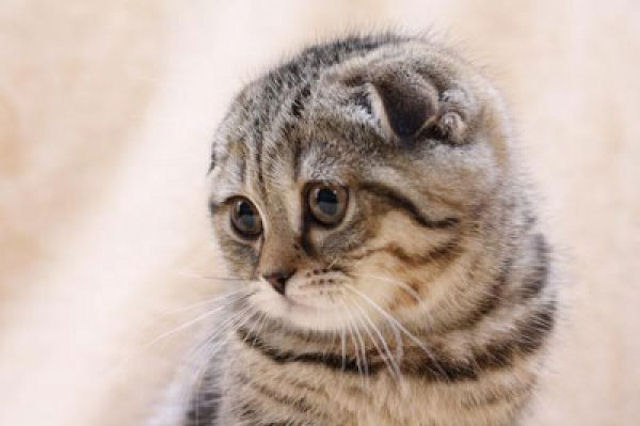
But other clubs of cat lovers, CFA and WCF, in 1974, recognized the Scottish Fold cats as a test breed, and four years later at the elite exposition in the United States the Scottish folds received enthusiastic reviews of felinologists and fans.
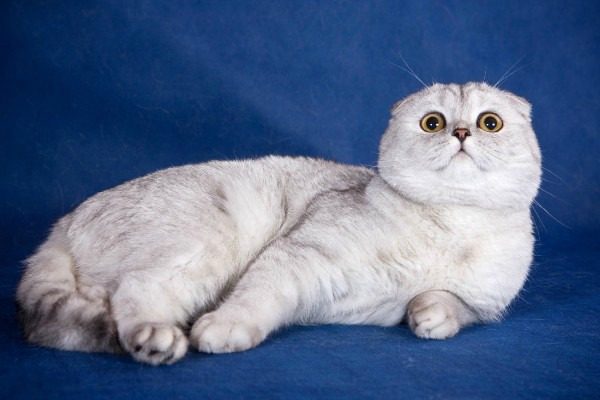
Since that time, these charming cats have turned into full-fledged contestants of various international feline exhibitions.
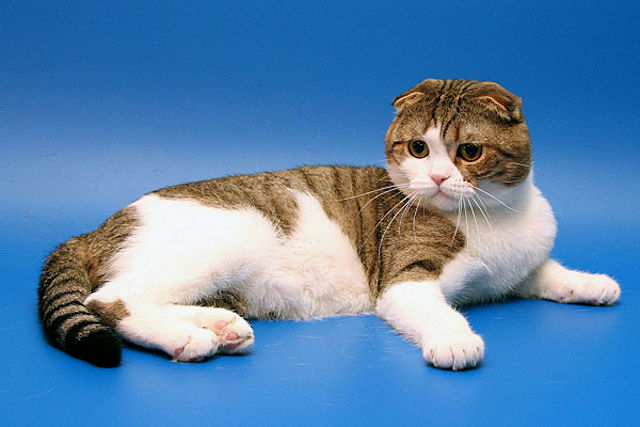
Species of Scots
Scottish cats with lowered ears, Scottish Fold, are one of the categories of cat with short hair and a bunch of ears. Scottish pryamouhie, Scottish Straight, is a breed subspecies whose specimens have rather short fur and protruding ears.
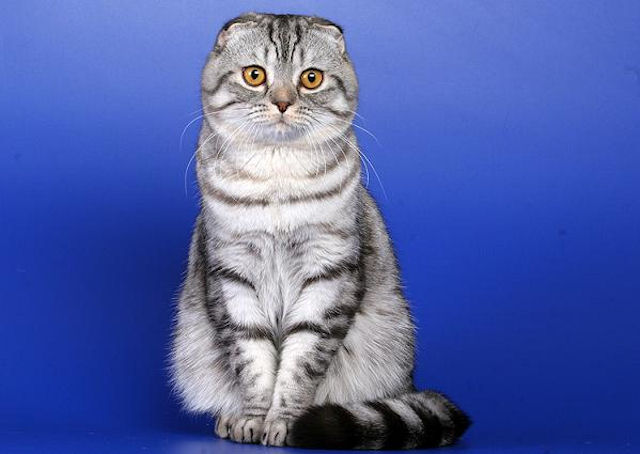
Longhair (Highland) lop-eared Scots have luxurious fur and pressed ears. Longhaired pryamouhie - cats with long fur and erect ears.
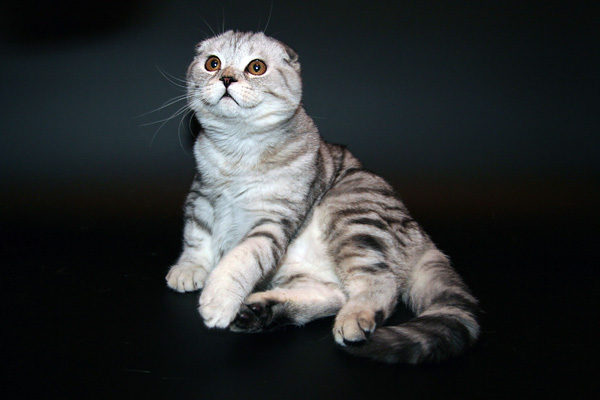
Appearance
Scots are born with ordinary even ears. And only at the age of 5-7 months they are able to change the form (to descend).
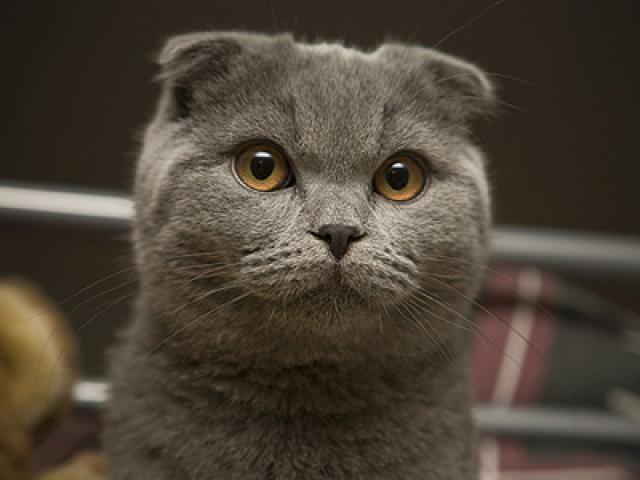
In addition, the measure of fit to the head differs. Scottish kids, who did not touch the ears, will be straightforward throughout life. The causes of this phenomenon have not yet been studied by feminologists, so the number of lop-eared kittens is always unpredictable.
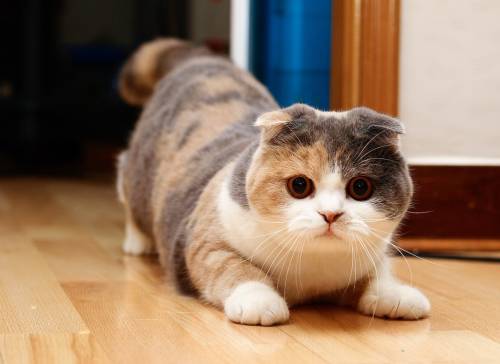
Differentiate the single, double and triplicate folds of the ears of the Scots. In the post-Soviet space, there are usually single and double folds.
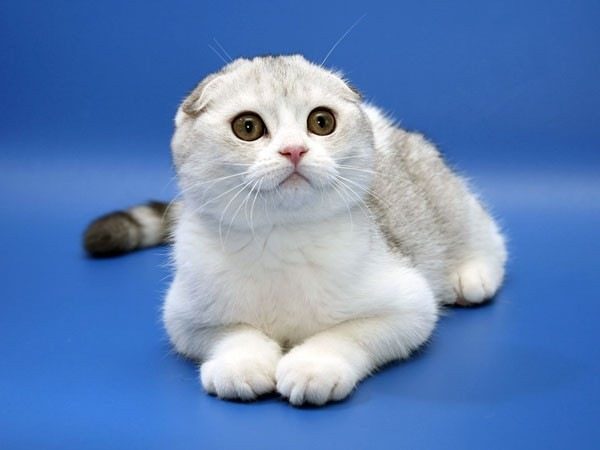
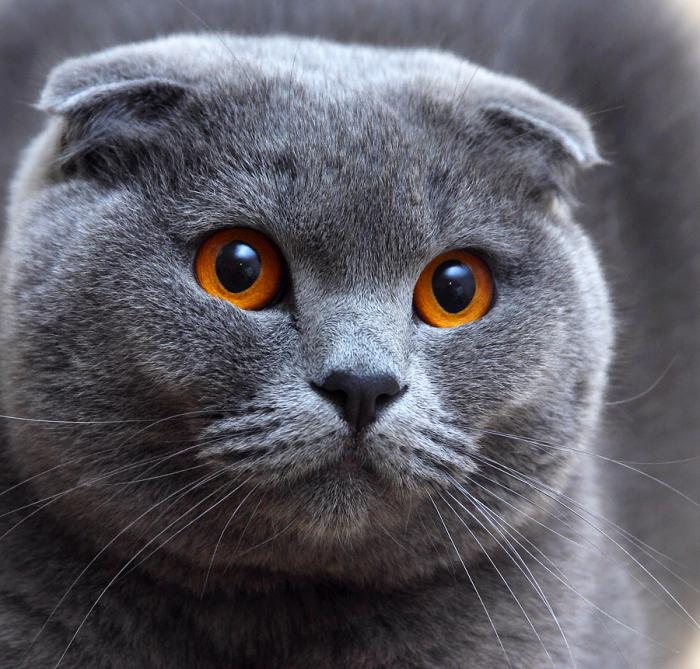
Standart breed:
- The trunk of the Scottish Fold is not very large. The weight of such a cat fluctuates around four kilos. Cats of this breed, as a rule, are larger, and can weigh up to eight, and even up to ten kilos.
- Beauties from Scotland, whose pictures are able to charm and the most exasperated person, have proportional figures. Their bodies have a good musculature, a strong neck and relatively short massive paws, whose ovality gives toy kittens a playfulness.
- Tails usually fairly short, wide at the beginning and narrowed to the end.
- The view from the side to the muzzle impresses with greatness. Scottish folds have large spherical heads. For them, common are extended, slightly flattened and hunchbacked noses, large chubby cheeks with tendrils sticking out and massive chins.
- The ears of these cats are rather small, rounded off at the ends. They are adjacent to the head and cover the ear canals.
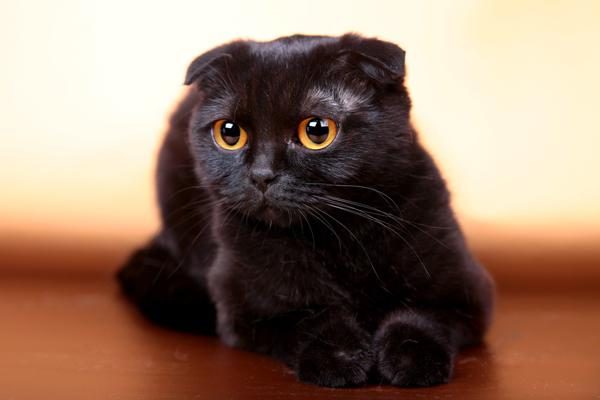
- The eyes of the representatives of this breed are set far apart. Their coloring is combined with the coloring of fur.
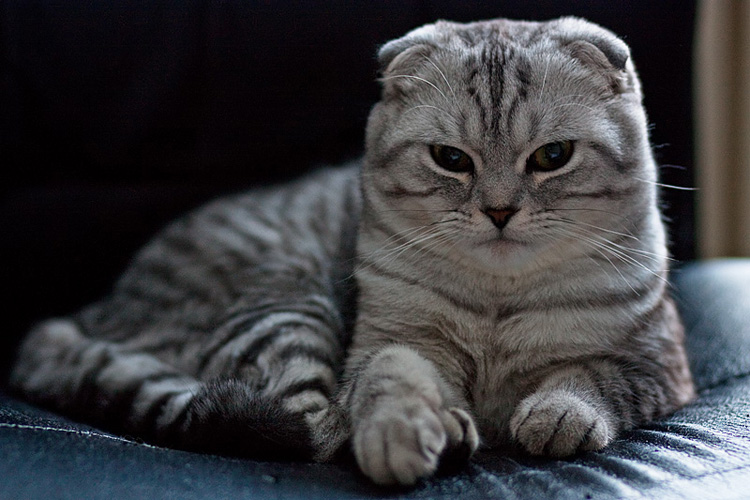
- The coat is thick, short, as if plush.
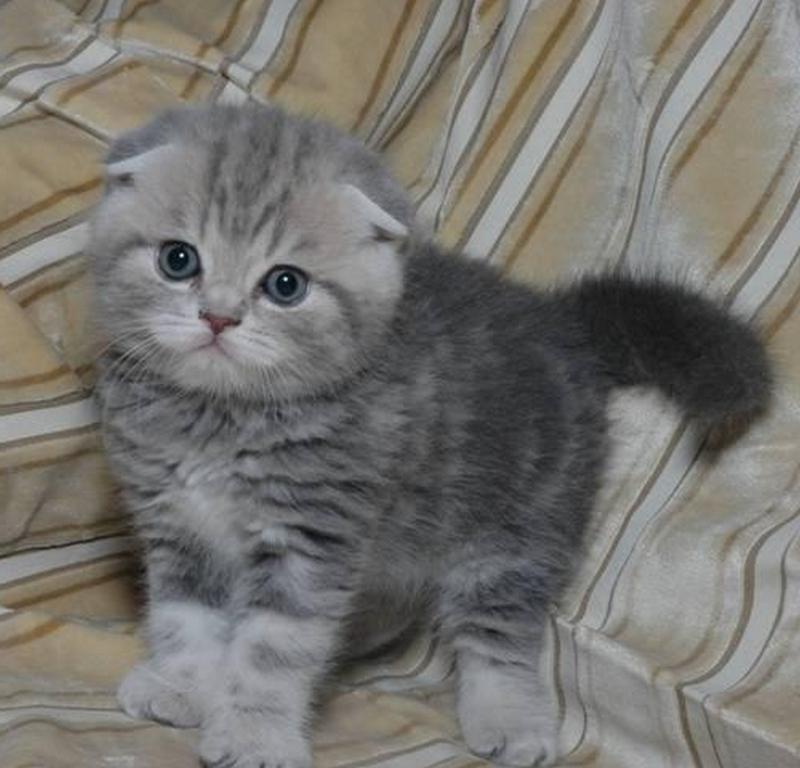
Possible colors
Scottish folds inherited from Britain a great variety of colors and patterns. It is often possible to see cats of solid (solid). They are black, ash-brown, blue (cold gray tone), peach, snow-white, mustard, lilac. There are Scots multicolored, with patterns and all sorts of points.
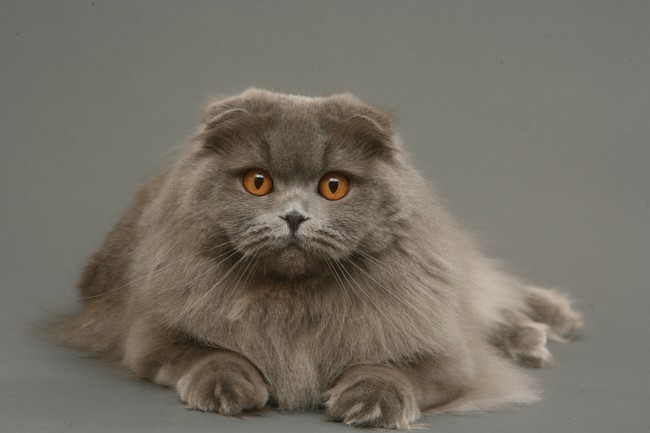
Non-monotonous Scottish lop can be of such colors: smoky, tabby, chinchilla (see), two-color, color-point and tortoiseshell.
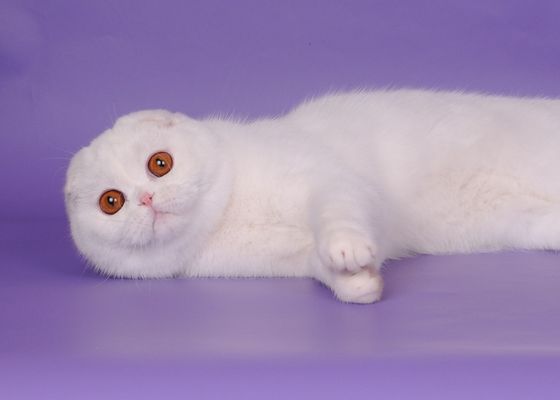
Disposition and habits of Scottish folds
The nature of the representatives of this breed is almost the most important plus. These animals are very kind. They are balanced, majestic and, at times, cheerful.
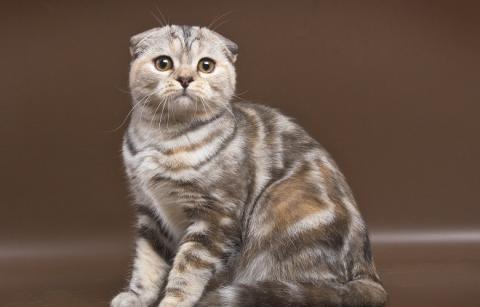
According to the owners of the Scots, such pets are very fond of their owners, get along well with the kids, frolic with it, not showing claws. They are very gentle and non-bullying creatures.
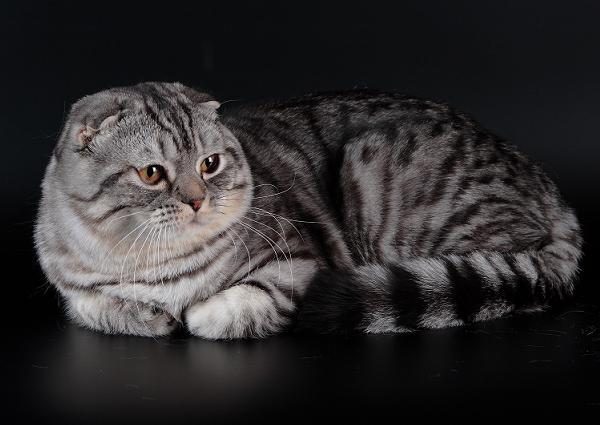
Scottish Fold does not give a vote for nothing. Their meowing is either very thin, or slightly creaking. Scottish folds easily adapt to any family, whether extended or consisting of no more than a couple of owners who have more pets or not.
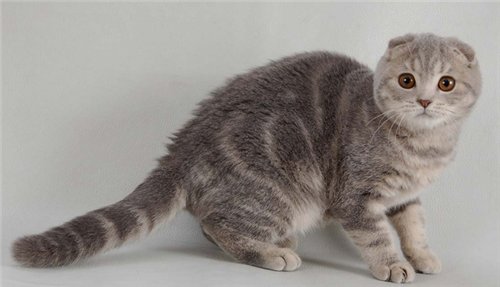
Feedback from the owners of the Scottish fold about their disposition and habits is entirely positive. These cats are excellent companions for those who do not like fuss, who live slowly, calmly and calmly.
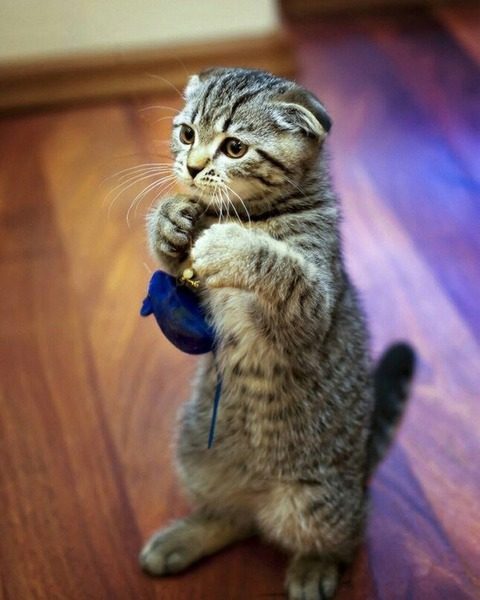
Kittens of this breed, even small ones, usually do not hooligan very much. They can never be seen dangling on curtains or sipping from a chandelier. But they like to play with small things.
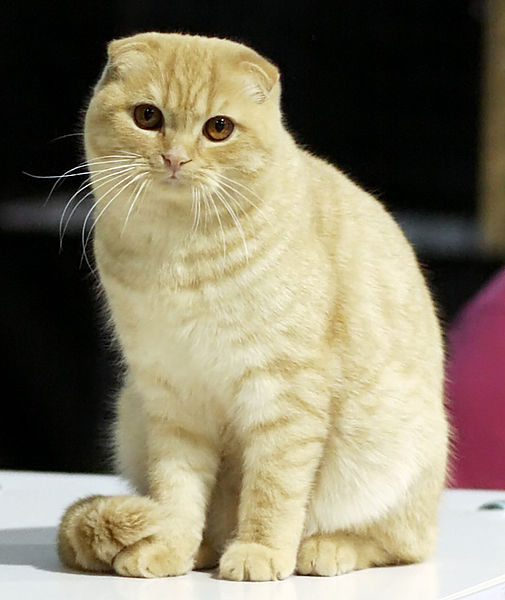
They can take them in the teeth, take away somewhere and hide in secret corners behind pieces of furniture.
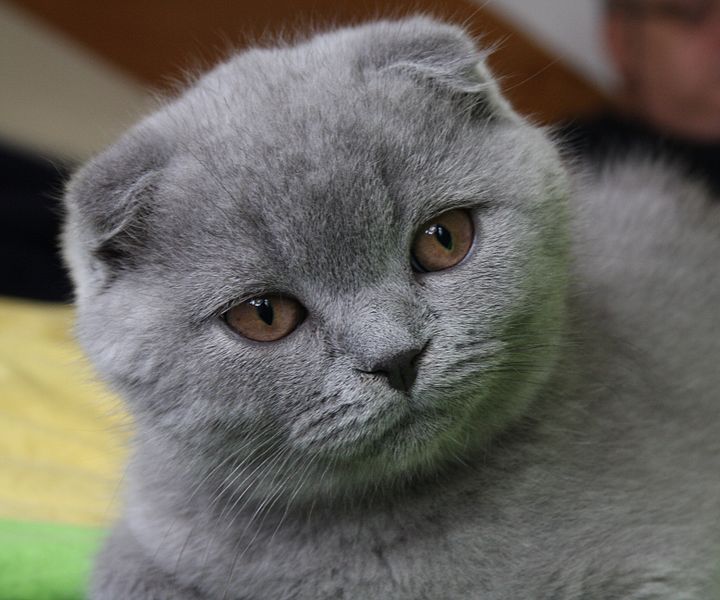
Often in the observations of the owners, it is said that these cats like to get up on their hind legs from an early age, thus practicing their backbone.
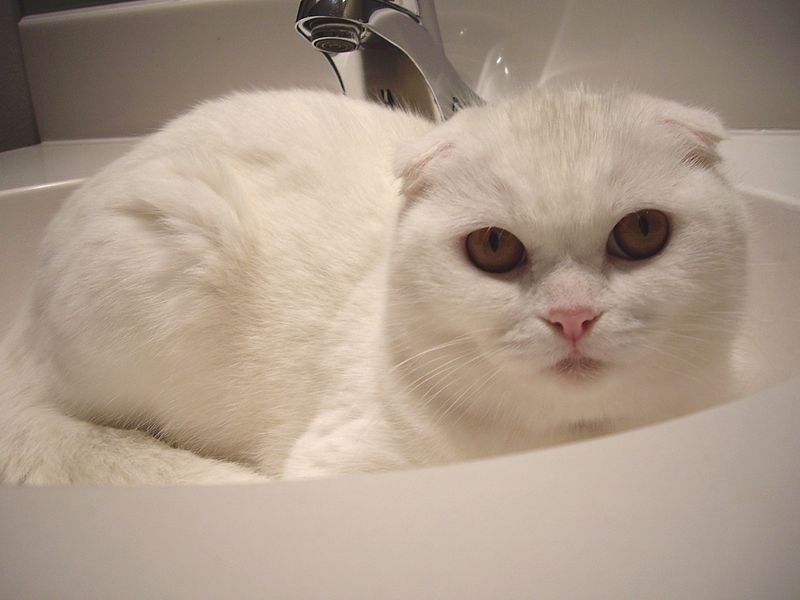
Scottish folds like to keep themselves clean, they are intelligent and have a sense of humor. Noticing that their toy was in human hands, they will readily rest and admire how the owner will play with it.
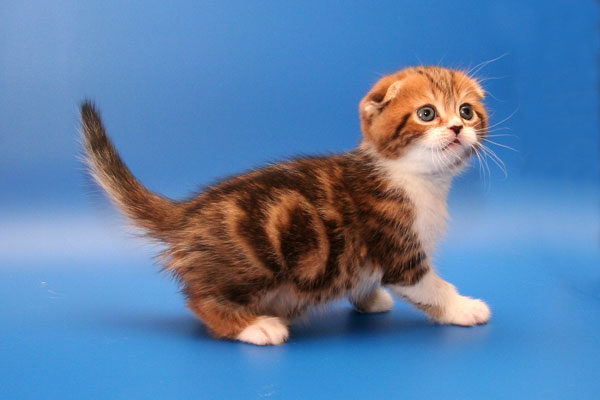
Grown up Scots with a born elite grace graciously allow people to look at themselves, while remaining, meanwhile, gentle, peaceful and understanding. These seals show obedience when it is convenient for them.
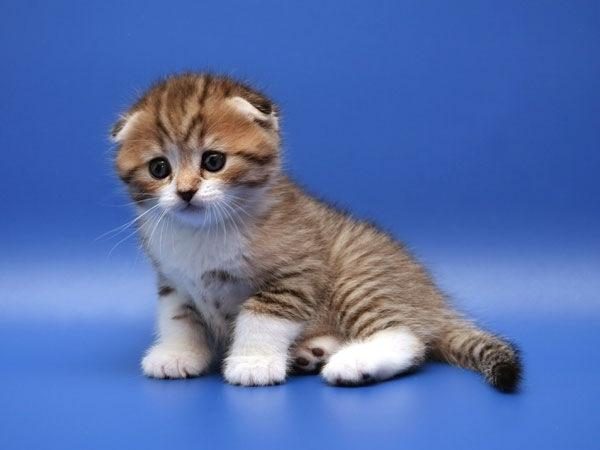
And they can be stubborn if they do not like something. In contrast to a related British breed, which is peculiar not to notice the presence of people, the Scottish Fold easily begin to communicate with a person, identify themselves pets among household members and happily spend time with them. Cm. .
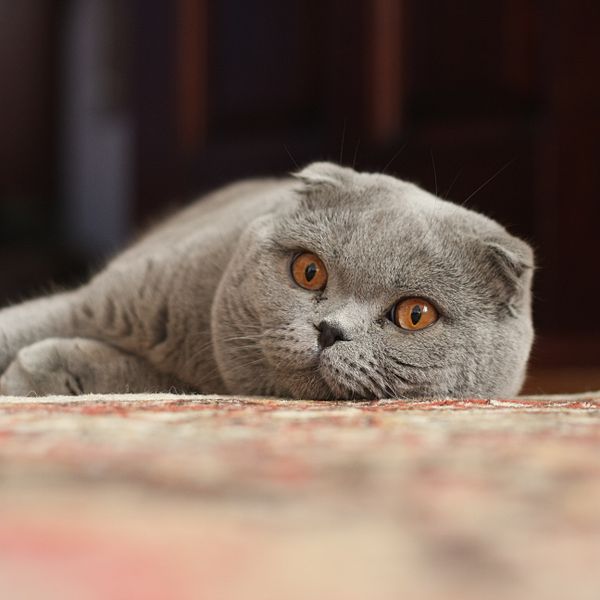
Care
These seals are not capricious. They have a neat environment, clean drink and the right food. Babies should be given food several times a day. At night, no food, only drinks are exhibited.
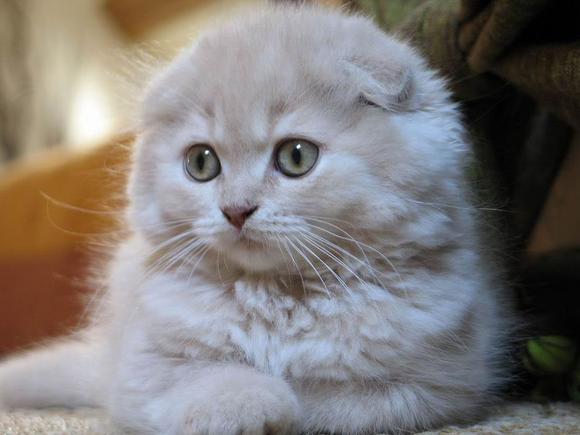
The menu of this breed can consist of elite packaged forages, and of natural products:
- boiled breasts;
- beef;
- fish with low fat content;
- croup;
- sour-milk products (milk is contraindicated);
- protein from eggs.
The Scottish Fold should not be given food with fat and salt. Toilet bowl these pupils master easily.
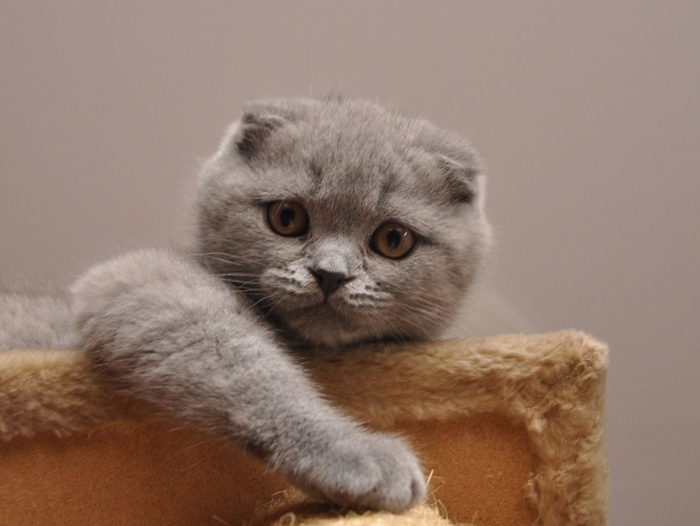
Take care of representatives of this breed is not difficult: 2-4 times a month you need to clean your ears with turundochkami. When there are dark secretions in the eyes, it is necessary to clean them with a moistened napkin.
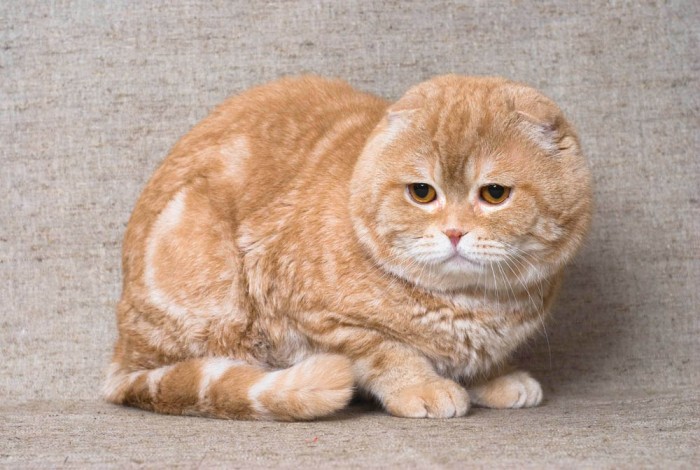
Scottish folds are very fond of their own scribbling and do not encroach on wallpaper and furniture upholstery, which is an exceptional advantage of the breed.
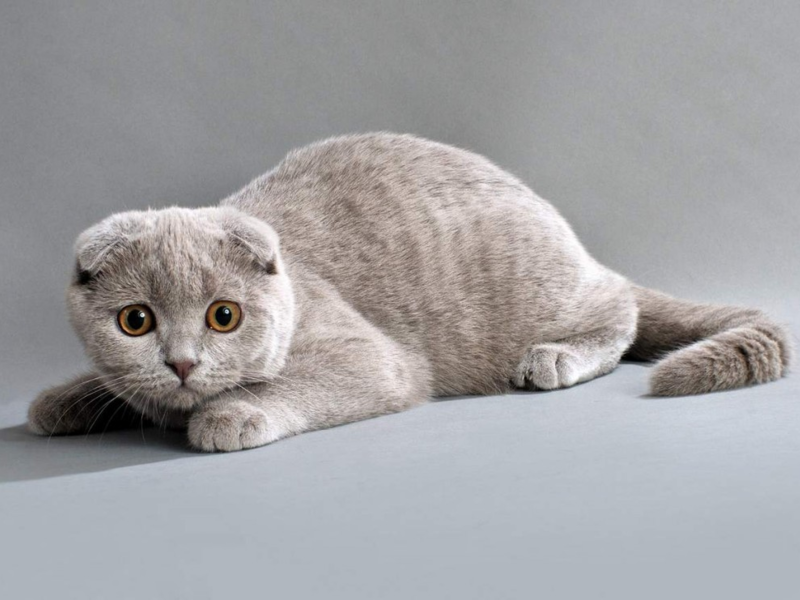
Requirements for binding
In order to have full-fledged cubs from a scallop, you only need to pair it with a Straight Scotsman!
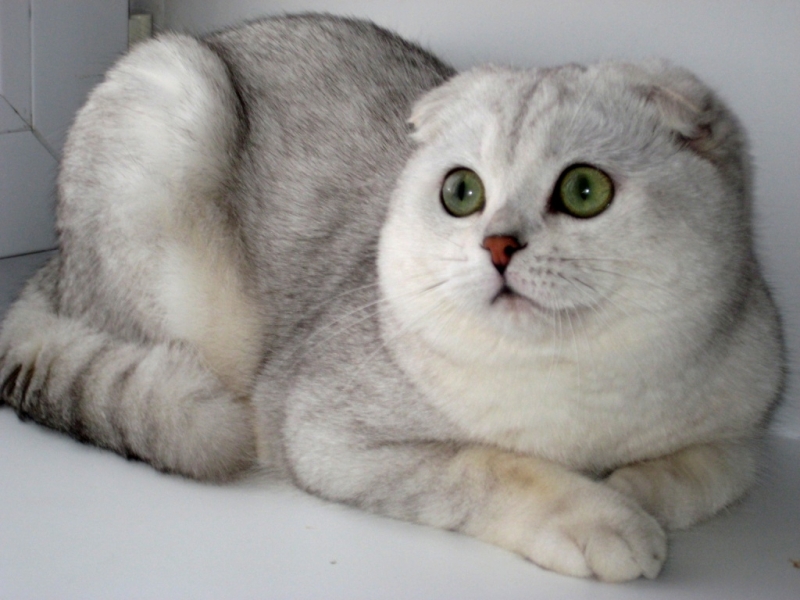
Observance of this rule allows, almost certainly, to avoid occurrence of deviations of skeleton and joints at the future offspring of lop-eared beauties from Scotland.

Cubs that are born as a result of pairing the two Scottish folds often have congenital pathologies of the skeleton, and when they grow up they acquire all kinds of ailments of the musculoskeletal system.
Unique characteristics of the breed
Owners of Scottish folds share their observations. For example, some scots love to dream, stretching their paws forward.
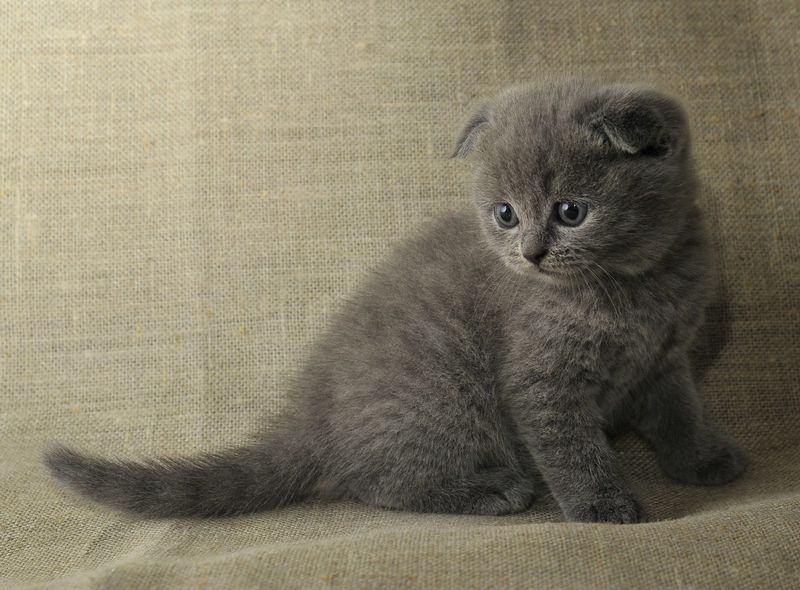
Surprisingly, these cats are unique in their kind by the fact that they can easily sleep on the back.
Becoming at attention to the hind paws, when the cat begins to resemble a ground squirrel, is peculiar only to the Scottish Fold.
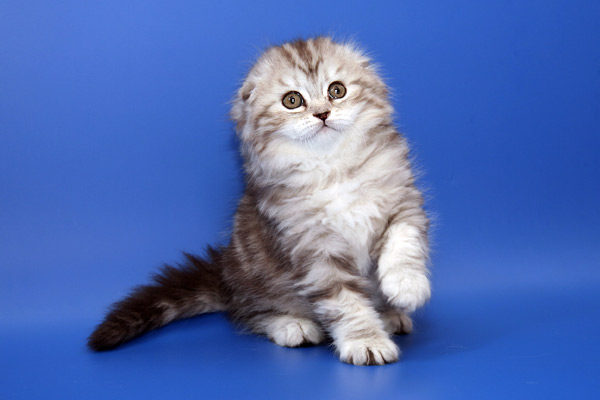
Even the owners testify that their pets adore massage done by comb. It is noteworthy that they do not mind, that they are combed though along, even against the coat.
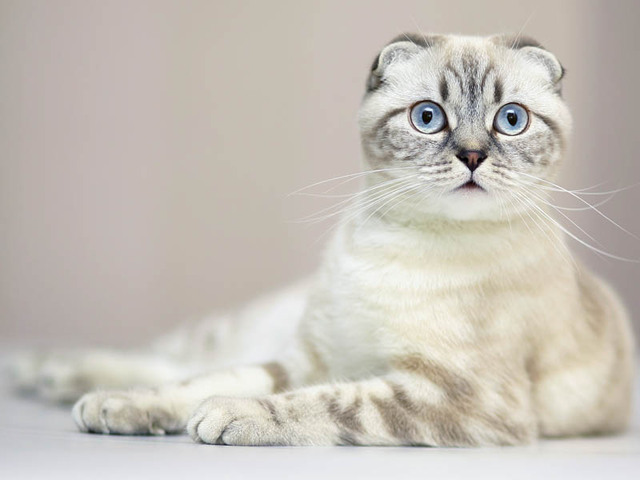
Basically, owners of Scottish folds are unanimous in the opinion that cats of this breed are excellent pets. They are gentle, intelligent, easily yieldable to training. Well, their unique exterior always touches everyone.
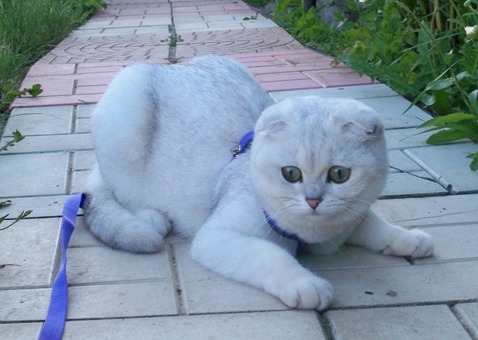
The Scottish Fold has a single serious minus - hereditary diseases. If there is chondroosteodystrophy or hemophilia, specialists prescribe a course of getting rid of the symptoms. The same animals, who were lucky to avoid genetic ailments, have good health.
Popular nurseries of this breed:
- Russia - (here is your kennel);
- Belarus - (take the place);
- Ukraine - (apply).
With the appearance of a cat in the house, the atmosphere in it becomes warm and positive. Each of the breeds is remarkable in its own way, but none of them, perhaps, can match the Scottish Fold of a Cat. Its kind of funny and cute plush cats with tightly pressed to the head ears cause delight.
History of the origin of the Scottish Fold
The homeland of these wonderful creatures was Scotland, hence the name of the breed, which leads the history of its existence since the 60s of last century. On one of the village farms lived a half-wild kitty with a tabby color. Once she brought offspring from an unknown cat, in the litter was a young female, a remarkable feature of her appearance was a peculiar form of ears, as if folded by an envelope. The baby was called Susie.
The grown cat actively began to produce kittens for light, which the owners of the farm barely had time to give to their acquaintances. One such unusual baby was acquired by a certain Mary Ross, who was unusually interested in the unusual appearance of the kitten and even consulted about this with specialists.
The new breed made an impression on the breeders, who began to cross the fold with the British. The result of the activity of felinologists was the birth of the first representatives of the Scottish breed.
However, in the 1970s, scientists established a ban on breeding folded cats, arguing that this was a complex treatment for ticks due to the unusual shape of the ears. In addition, most of the kittens were born deaf, many newborns had a fusion of vertebral joints, curvature of the limbs.
Breeders had to work hard to eliminate these characteristics of the breed. They came to the conclusion that the folding is possible only with cats, whose ears are straight. As a result, in one litter can be and pryamouhie (Scottish straight), and fold (Scottish Fold) kids. While the kittens are still small, it is impossible to determine which ears they will have afterwards.
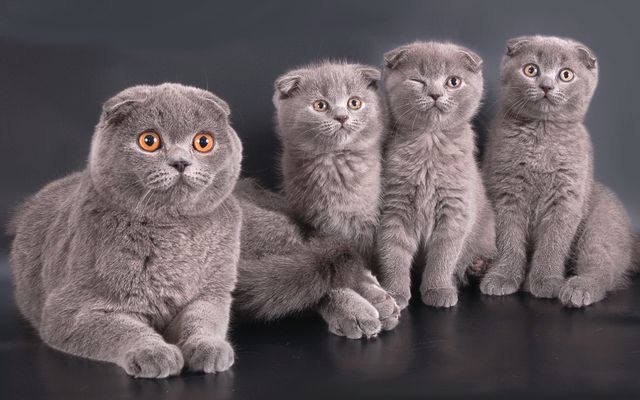
Recognize their form can be no earlier than 3 weeks after birth. Outwardly, these two subspecies of the breed are the same, the difference is only in the form of the ears: in the folds the ears are lowered and folded, they will stand in the straights.
By the way, Scottish Straight and Scottish fold are not all varieties of Scots. There are also highland folds (long-haired lop-eared) and highland straights (long-haired prmouhie).
Description, the standard of the breed of Scottish Fold cats
The charm of the Scottish fold of the kitty lies not only in the lowered ears, but also in wide-open eyes, a childish naive face, soft, fat cheeks. The weight of adult cats often reaches 10 kilograms, cats are much smaller.
Characteristics of external features:
- The body is strong, medium in size.
- The musculature is developed.
- Paws are oval, neat. On the front paws there are 5 fingers, on the back - 4 pads. On the pads between the fingers - bunches of wool.
- The tail is medium, proportional to the body, flexible and mobile.
- Wool is short, dense, plush. On the neck - a thick "collar". Cotton wool is considered a disadvantage of the breed.
- The head is rounded, the jaw is well developed.
- Muzzle with well-formed puffy cheeks and roundish pads of vibrissae.
- Neck short, strong.
- Eyes spherical, large, widely planted. The color corresponds to the color.
- The nose is snub-nosed, broad, not having a significant transition. A small stop is allowed.
- Ears small, with rounded tips. The stronger the ears are pressed to the head, the more valued the animal is.
- The chin is hard.
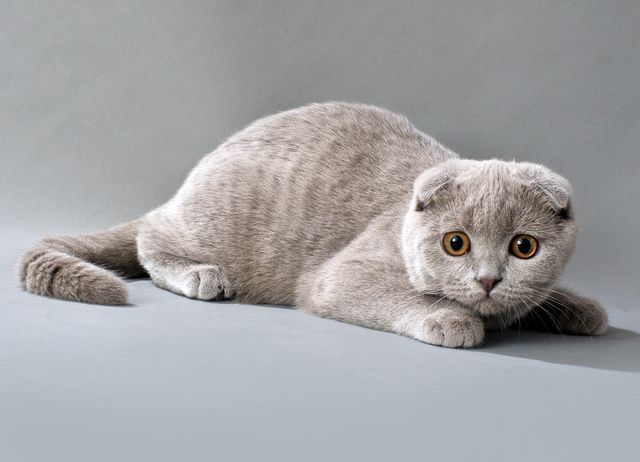
The breed of Highland Fold cats is different from the fast-witted folds with thick long hair and a luxurious fluffy tail.
As for the color of wool, the most popular are black, chocolate, clarified blue, smoky, cream, lilac, tortoiseshell, chinchilla, figured, color point. Eye color usually depends on the color. As a rule, the folds have orange or copper eyes. There are golden, emerald, blue are only at the color of the color point.
The nature of Scottish Fold cats
Cats of Scottish Fold breed are extraordinarily mobile, playful animals. They have high intelligence and developed intuition, adapt quickly to a new place of residence and even at a distance are able to feel the mood of the owner. If he is not in the spirit, the plush cat will try to play along with the beloved to calm and lift the mood.
Scottish Fold cats are characterized by a mild calm and sensitive character, are not at all aggressive, but they do not tolerate screaming. If the owner does not want his pet to grow cowardly and weak, he should not raise his voice.
A small kitten will choose from among all the people living in the house one person and will consider him a leader. Other family members will be treated with condescension. Ideal for families with young children, the elderly.
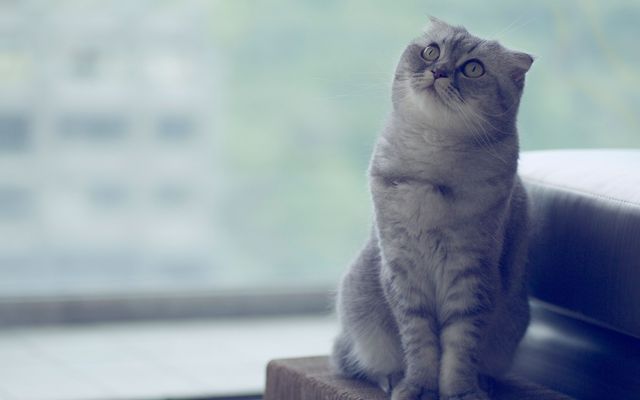
Folds belong to the breed of "silent" cats. They almost never meow, but when they need something or publish specific sounds resembling a creak, or they pursue the owner with a reproachful look.
Scottish Fold cats are smart, smart and trained. Kittens, as a rule, quickly get used to the tray and scratching. If to bring up the kids correctly, they will understand that it is impossible to climb on beds and tables.
An amusing feature of the folds is their habit of standing on their hind legs, like a column. This pose not only means the highest degree of interest, but also serves as a kind of warm-up for the spine. Specificity of plush folds - they like to sleep on the back, stretching their limbs in different directions, than bring to the emotion of all who observe this spectacle.
Cats rarely arrange riots and spoil hostilities. For this folds are too well brought up and obedient, besides they are afraid of heights and do not show any desire to scramble up the curtain to the ceiling or climb onto the cabinet. No, they better look at the TV together with the hosts or play with the little one, who simply adores plush teddy bears!
Cats are completely undemanding in everyday life, easily adapt to new conditions, and since they can not exist without a host for a long time, they happily accompany him on travel, so the character of the Scottish Fold cats is simply wonderful!
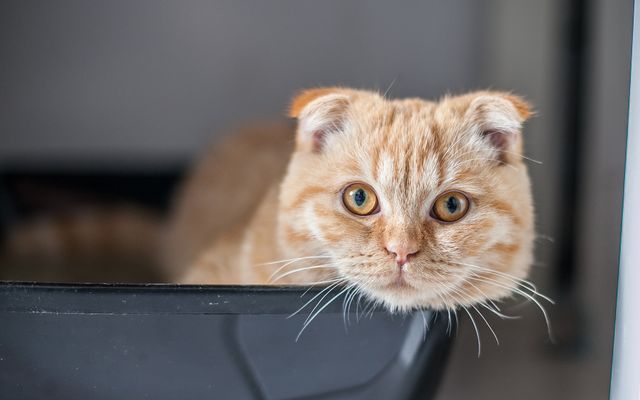
Care and maintenance of the Scottish Fold
All that the pet needs is compliance with the following hygiene procedures:
- Check the ears once every two weeks and clean them with a cotton swab. In the auricle there should be no dark plaque, mucus and rashes, and in gray - an unpleasant smell. If the pet shakes his head and scratches his ears, it means that he settled in them ear mite.
- Shaving of brushes (longer hairs) from the ears.
- Daily wiping eyes with a cloth moistened with warm water.
- Mowing claws every 2-3 weeks. The procedure should be done very carefully, so as not to damage the blood vessels.
- Bathing as needed.
- Timely vaccination and deworming.
Scottish Fold requires care, contained in combing the fur coat twice a week. To do this, you need a special metal comb, which first combs hair in the direction of hair growth, then against it. The breed of Scottish cats highland fold is more demanding for care - their luxurious fur coat should be combed 2-3 times a week, in order to avoid the appearance of coils.
Walking with folds is optional, but veterinarians believe that fresh air will be useful for animals.
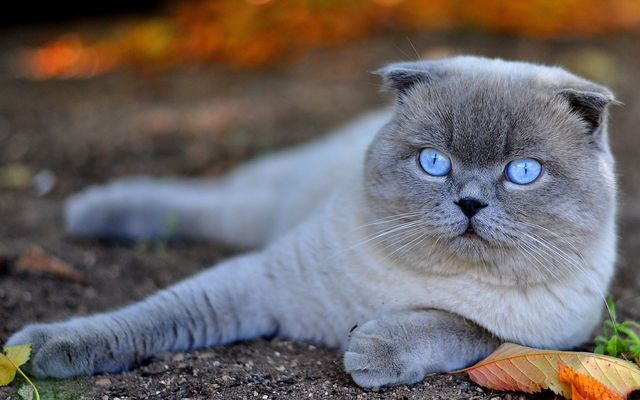
How to Feed Scottish Fold Cats
Folds can be fed both natural food, and special food, most importantly, do not mix them with each other. If preference is given to naturalka, then the diet should be balanced and include the necessary amount of proteins, vitamins and macronutrients.
In the cat's menu, meat (chicken, beef) and offal (liver, heart, lungs), boiled fish of sea varieties without pits must be present. It is recommended to give the domestic pet dairy products - low-fat cottage cheese, kefir, sour cream. Milk is given only to kittens up to 3 months.
Folds are very useful porridge, cooked on water or broth, vegetables in the form of puree, egg yolk. And also in the diet of the pet must be a herb that helps purify the stomach. It should be purchased at pet stores, but not torn on the street.
Finished cat food is good because it already includes the necessary amount of nutrients necessary for the full development of the cat. Of course, we are talking about super premium foods. This pleasure is not cheap, but you can not save on pets. A castrated cat must be fed with the appropriate food.
To make your pet grow up healthy, you should take care of the feeding utensils, keep it clean, and provide the animal with access to fresh water.
Adult cat (after 8 months) should be fed 2 times, kittens - 4 to 6 times.
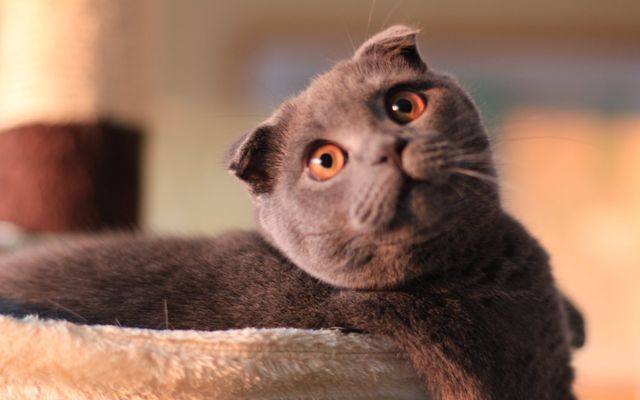
Diseases of Scottish Fold cats
Special attention should be paid to bent ears, since they formed during the mutation of the gene, which makes them susceptible to all sorts of diseases.
A Scottish Fold cat may have the following diseases:
- ear diseases;
- eye diseases (increased lacrimation, with age - cataracts, glaucoma);
- diseases of the bone and musculoskeletal system;
- skin diseases (osteochondrodysplasia);
- diseases of internal organs (breathing disorder, urinary incontinence).
Particularly alarming is the disease, osteochondrodysplasia of Scottish Fold cats. This is a hereditary disease caused by the same gene that twisters the ears. The disease is expressed in the deformation of the skeleton of the spine and paws. The tail in the cat is partially or completely deprived of mobility, the gait becomes chained, and lameness may appear. Treatment oteochondrodysplasia is almost impossible. In order to prevent this disease, it is forbidden to cross two lop-eared individuals.
How many live Scottish Fold cats? It depends on the conditions of detention. With good care, they can well live up to 22 years. The average life expectancy is 15 years.
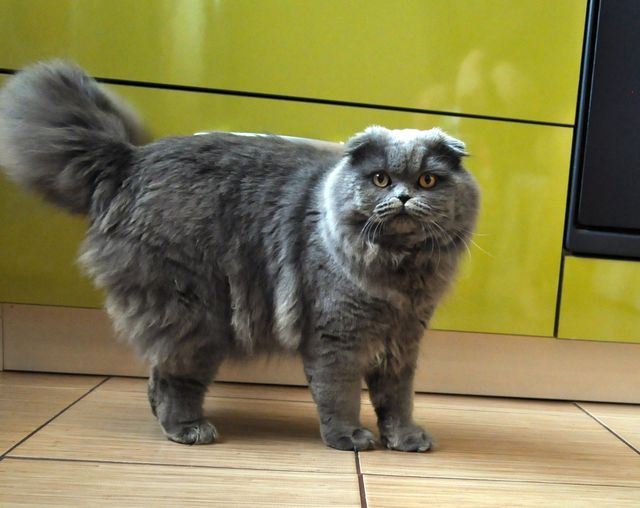
How much does a Scottish Fold cat
Prices for small folds vary from 12 to 20 thousand rubles, depending on the class. Of course, the exhibition (show) or breeding (breed) kitten will cost more than a kid of the pet class, intended solely for domestic maintenance and who will later be castrated (about when to castrate a Scottish Fold cat, you need to consult a veterinarian).
Cats highland fold Scottish Fold can cost up to 25 thousand rubles.
Nurseries for breeding Scottish Fold cats in Russia are many, so the acquisition of a kitten will not be a problem. Breeders are obliged to provide a purchase contract, a veterinary passport with vaccination, transfer or metric, which are then exchanged for a pedigree, provide the necessary information about the parents of the baby, the features of its feeding and maintenance.
Before you buy a small Scot, you need to carefully inspect it and be sure to gently feel the tail - it must be mobile.
The peculiarity of the Scottish Fold of the breed lies in the form of its ears, which is not characteristic of other cats, it was once considered a defect, very transformed the animal and became the impetus for the creation of a new breed. It was formed with the participation of British and American shorthair cats.
Not all the world organizations accepted with enthusiasm the breed with such non-standard ears. Only CFA and WCF in 1974 recognized the Scottish Fold cats as a test breed, and four years later at an elite exposition in the US, the animals of this breed were greeted with enthusiastic reviews by felinologists and ordinary spectators. Since then, these charming cats have become fully involved in various kinds of exhibitions.
- Scottish-Straight have a short coat and straight ears;
- Skotish fold - short-haired and with lowered ears;
- Highland folds - the fur is long and the ears are close to the head.
- Highland Straits are long-haired with straight ears.
In addition to the unusual appearance, Scottish cats have other characteristics in behavior. They are very fond of standing on the hind legs. This is not done to attract attention and not in order to better discern something, but for the purpose of warming up the spine. Another feature is their fear of height, so they can not climb onto the cabinets and hang on the curtains, for their entertainment these cats choose more aristocratic methods.
- the body has an average size, developed musculature, the maximum weight of the female is 4-5 kg, the male is 8-10 kg;
- neck short and sturdy;
- legs are massive, paws have an oval shape;
- tail short and wide, tapering to tip;
- the head has a spherical shape with large puffy cheeks, a massive chin and a flattened, hunchbacked nose;
- ears small, adjacent to the head, rounded at the ends;
- eyes large, widely set;
- wool thick, plush.
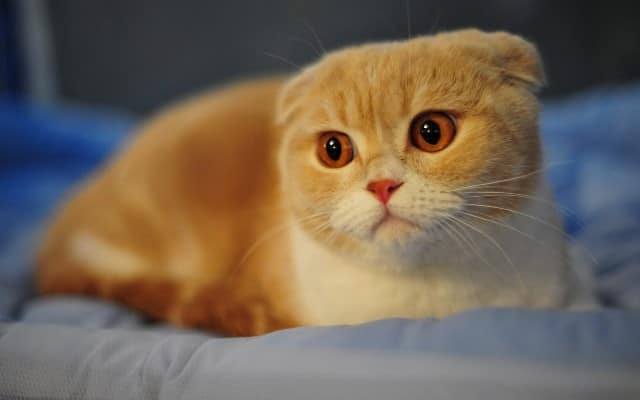
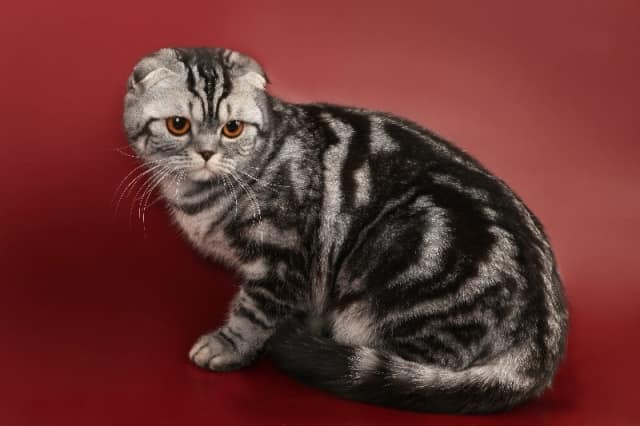
Kittens are born with straight ears. Only when they reach the age of 4-5 months they can change their shape and lie on their head. The form of their clamping to the head can also be different. Single, double or even triple folding of the ears is singled out. More valuable and more expensive is the Scottish Folded Cat, which has a triple fold of ears, which have the most snug fit to the head, repeating its contour. Kittens, who have not reached the age of reaching a certain age, remain with straight ears for life. The regularity of this process has not yet been clarified, so the number of Scottish folds in the litter is unpredictable.
The character of the Scottish Fold
The Scottish Fold cat, whose character is one of its significant advantages, is an animal with a good soul, calm behavior, aristocratic manners and moderately playful. These cats are very fond of their owners, perfectly get on with children and other pets. One of the distinguishing features of these creatures is taciturnity, they mew quietly and rarely.
Such cats are perfect for people who do not tolerate fuss and lead a calm, measured life. Even in childhood, kittens of this breed hooligan in moderation and do not bring much damage to housing. But, though they can hide in the secluded places a variety of small items, for example, glasses, pencils, pens.
Scottish Fold cats are very clean and smart. Adults are gentle, calm and understaffed. They can obey if the request is in their interest. But they also show obstinacy if they do not like something.
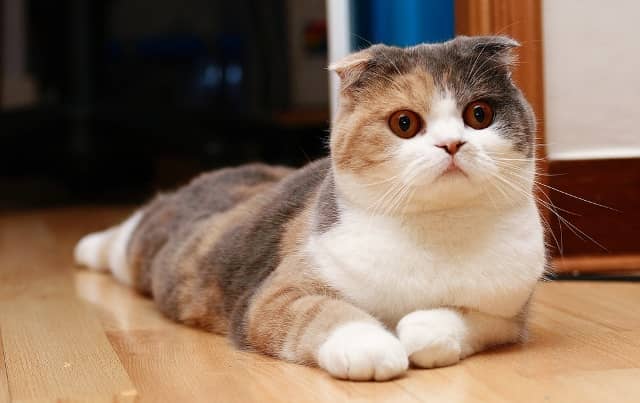
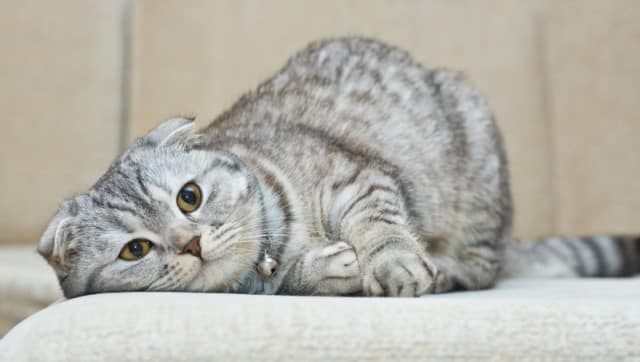
Unlike their close relatives of British cats, who can completely ignore the presence of a person, Scottish folds work well with people, choosing a favorite, and often being near him. But despite the devotion, these cats are not at all intrusive, they prefer to be near the person, but not on his hands.
According to many hosts, the Scottish Fold cat likes to meditate, stretching its paws forward. Also, these cats love to sleep on their backs, like a massage that they do with a comb.
Due to its gentle nature, softness and tenderness, a Scottish cat can become a wonderful friend for many years. Many owners consider the representatives of this breed to be ideal pets, who are rather playful, do not misbehave and easily yield to upbringing. And the appearance of these animals still could not leave anyone indifferent.
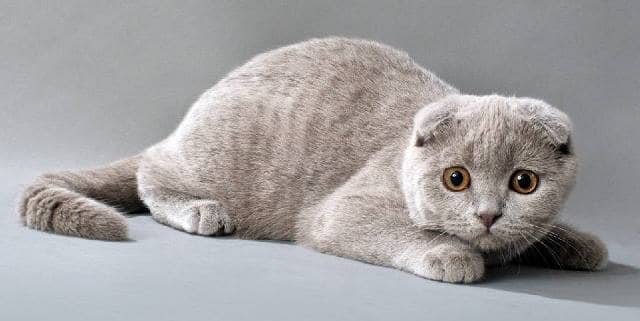
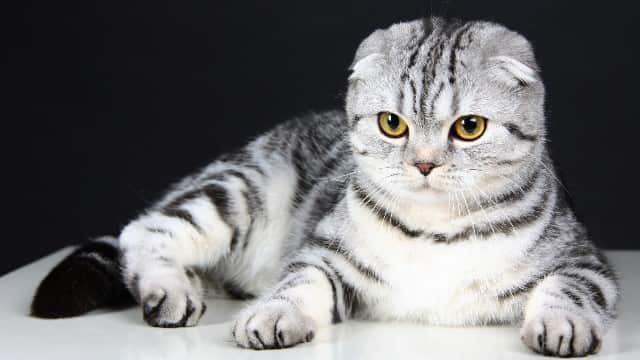
Breeding and care
Scottish Fold cat differs unpretentiousness and does not require special care. Twice a month you need to examine and clean her ears. Healthy ears inside should be free of plaque and unpleasant odor. Eyes with soiling should be cleaned with a damp cotton pad. Representatives of the breed like to use the kittens and do not spoil the furniture and wallpaper, which is their significant advantage. With a strong regrowth of the claws must be cut.
You need to bathe the cat every 1-2 months. Wool must be periodically combed out so that no collars develop. You need to do this first in the direction of growth, and then against it. This procedure gives the pet a great pleasure.
The diet of these cats should consist of their dry and important premium foods and natural products: breasts, beef, fish, offal, cereals, eggs, fermented milk products and fiber. It is forbidden to feed fat, fried, sweet and salty.
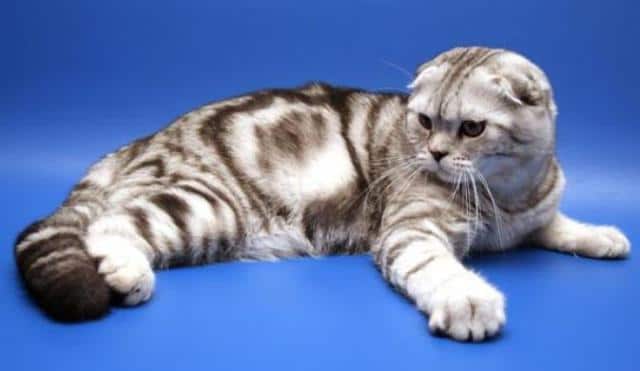
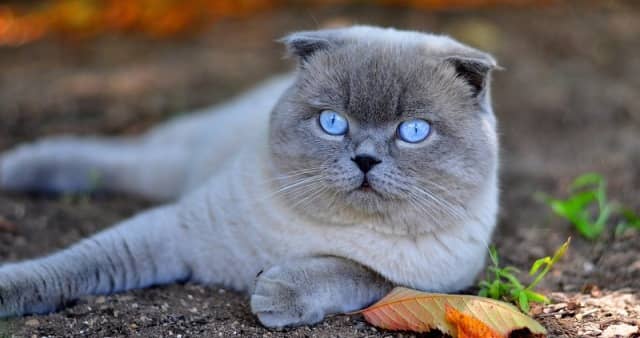
The shortcomings of these cats include weak bones and fragile health. But if you observe due care, you can avoid them. Representatives of this breed can live up to 20 years.
To obtain a good offspring, it is important to observe the following rules:
- The binding of the Scottish Fold cat should only be with a prickly cat of the same breed. If the cat has straight ears, then you must knit with the folded cat.
- Male for mating is better to choose a uniform color, since they are most in demand.
- If the female of this breed becomes pregnant, so that there are no complications it is better to squeeze less and protect from stress and small children.
Colors of the Scottish Fold
There are several types of colors Scottish Fold cats:
- solid (solid) - a uniform monophonic shade of fur without spots and patterns, the color can be black, chocolate, purple, blue or cream;
- tortoiseshell - a chaotic combination of spots of several different shades, the combination should be uniform, colors are distributed harmoniously;
- smoky - characterized by a homogeneous coat coat color and a silvery-white undercoat shade;
- chinchilla - painted only the eighth part of the hair, and the rest of the hair is white;
- tabby - color with tiger, striped, spotted, marble patterns;
- bicolor - a combination of white with blue, black or red, it is desirable that the white was on the legs, legs, stomach, chest, chin and part of the face;
- van - the color of the main coat is white, the tail and two spots on the head of another color;
- harlequin - the main part of the coat is white, and the fifth part of the other shade;
- colorpoint - the shade of all wool is light, and the paws, tail, ears, muzzle of contrasting color.
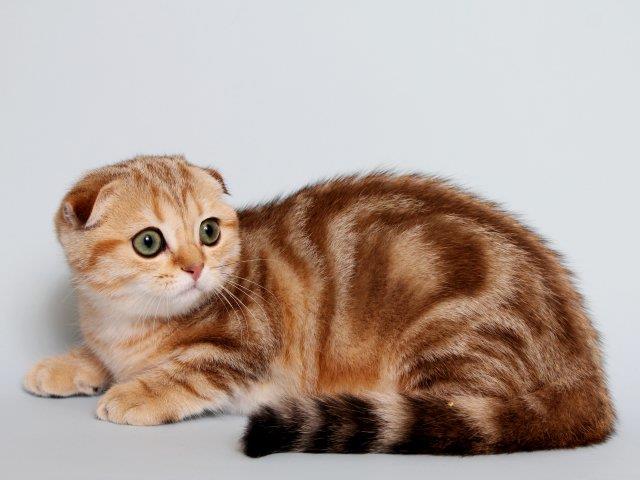
Name for Scottish Fold
A nickname for a cat of this breed should be selected in accordance with its character and appearance. It should emphasize all the charm of the pet. It is desirable that the name be short and clear, so that the kitten could easily remember it.
- Ariel,
- Barbara,
- Betty,
- Bead,
- Varvara,
- Greta,
- Jessie,
- Juliet,
- Zara,
- Ingrid,
- Coco,
- Cleopatra,
- Margot,
- Nyusha,
- Sessile,
- Trinity,
- Flossie,
- Helga,
- Yasmina.
- Archie,
- Brand,
- William,
- Smoke,
- Zeus,
- Lucky,
- Oscar,
- Pirate,
- Plato,
- Richard,
- Novel,
- William,
- Caesar,
- Charlie,
- Charles,
- Elf,
- Eugene,
How much does a Scottish cat cost:
- The price in Russia ranges from 5,000 to 15,000 rubles;
- The price in Ukraine is from 1000 to 6000 hryvnia.
Buy pets of this breed is better in a professional nursery, where the kitten will have a good pedigree and health. Also in the inheritance, along with the kitten, documents and detailed recommendations for care are transferred. Kittens from the nursery are given at the age of two months, already accustomed to the tray and kittens.
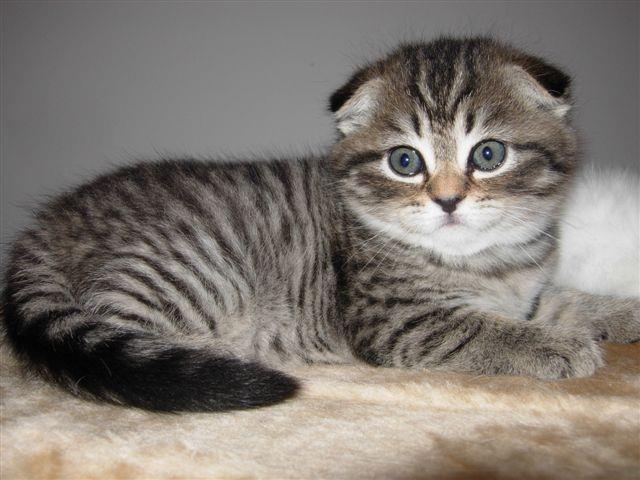
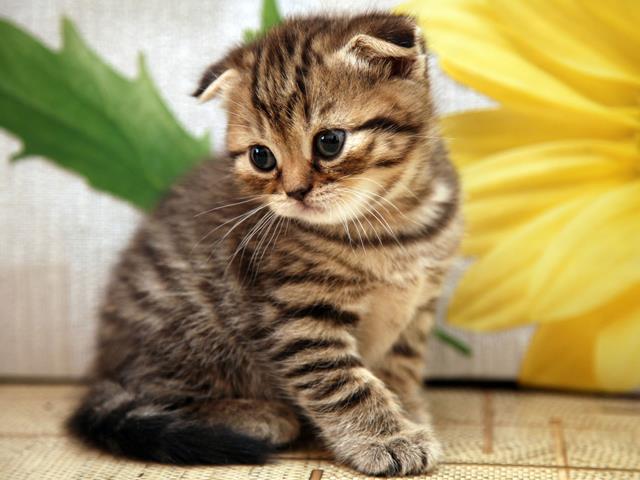
The breed of cats with hanging ears is quite young, appeared in Britain in the 61st year. To date, this breed is very popular all over the world. But breed breeding has a couple of nuances, there must always be someone with normal ears in the pair, otherwise the kittens can appear defective. And very often kittens are born with normal ears, which begin to drop only by the first month of life. Scottish Fold breed, it's also a Scottish Fold, one of the most beautiful breeds of cats.
Beauty lop-eared tartan 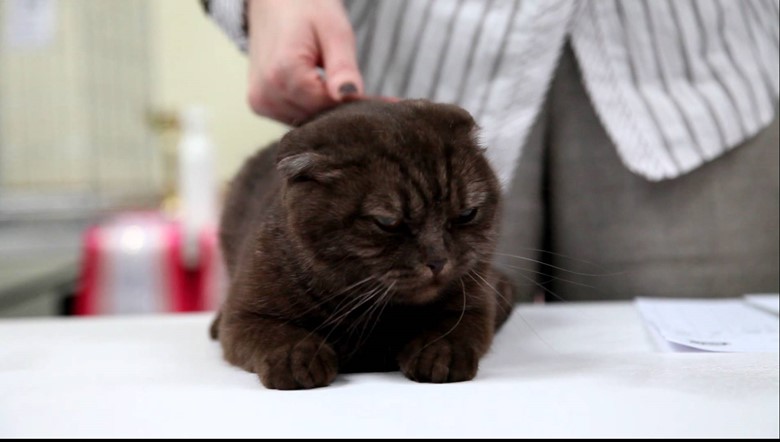 Terrible Scotsman
Terrible Scotsman
You will never see a Scot in cat's hysteria. They quickly begin to feel affection for the house in which they live, for their family, and especially for young children and the elderly, but at the same time remain sufficiently independent and unpretentious.
Another feature of the Scots is their unusual voice, unlike any other. Sometimes they can choose a pet in the family and follow it everywhere, but they will never allow themselves to be overly intrusive, so do not jump on your hands or knees if you are busy. They also easily get along with other pets.
It should also be noted - you can not shout at cats of this breed, this you do not teach your pet anything, but only cause psychological harm, as they are hard to tolerate a rough attitude towards themselves.
Care is not very difficult. Wool must be combed every day, they quickly get used to this procedure, and even begin to have fun. You can buy the necessary accessories in pet shop.
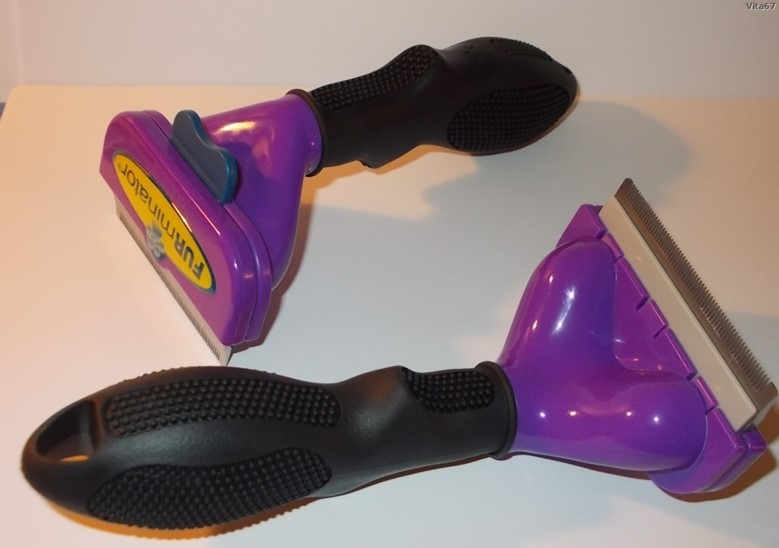 Tool for grooming
Tool for grooming To bathe only when it is absolutely necessary, they are also easy to apply to water procedures. Particular attention should be paid to the ears, because of the special structure they need to be examined and cleaned more often than other breeds of cats. Claws clipped several times a month, it is worth immediately buying a scratch and starting to teach.
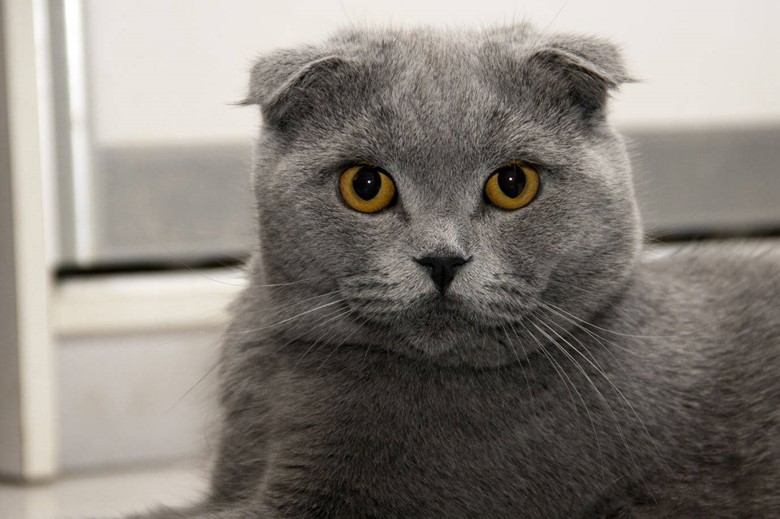 Well-groomed cat
Well-groomed cat And remember - we are responsible for those who have tamed!
Scottish fold, about the breed from A to Z
If you find an error in the text, then select this section with the mouse and click Shift + Enter or . Thank you!

